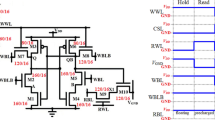Abstract
In this paper, we propose a diagnose strategy based on built-in current sensors able to detect the effects of single event transients (SETs) in SRAM memory decoders. By analyzing the effects, it is possible to mitigate the error by warning the system about the erroneous write and read operation or by circuit error correction avoiding catastrophic multiple bit upset errors. While EDAC can only protect faults in the memory cell array, the proposed method can cope with faults in the combinational memory circuitry. This BICS-based technique can be used in combination with EDAC to achieve high reliability in memories fabricated in nanometer technologies. Our methodology has been validated by Spice simulation and results show that our approach presents a low area, performance and power dissipation penalty.


















Similar content being viewed by others
References
Borkar S (1999) Design challenges of technology scaling. IEEE Micro 19(4):23–29
Buchner S, Campbell A, Meehan T, Clark K, Mcmorrow D, Dyer C, Sanderson C, Comber C, Kuboyama S (2000) Investigation of single-ion multiple-bit upsets in memories on board a space experiment. IEEE Trans Nucl Sci 47(3):705–711, June
Calin Th, Vargas FL, Nicolaidis M (1995) Upset-tolerant CMOS SRAM using current monitoring: prototype and test experiments. In: Proceedings of the IEEE international test conference on driving down the cost of test. IEEE Computer Society, Washington, DC, pp 45–53
Dodd PE, Massengill LW (2003) Basic mechanism and modeling of single-event upset in digital microelectronics. IEEE Trans Nucl Sci 50:583–602, June
Dodd PE, Shaneyfelt MR, Felix JA, Schwank JR (2004) Production and propagation of single-event transients in high-speed digital logic ICs. IEEE Trans Nucl Sci 51(6):3278–3284, Dec
Gill B, Nicolaidis M, Wolff F, Papachristou C, Garverick S (2005) An efficient BICS design for SEUs detection and correction in semiconductor memories. In: Design automation and test in Europe (DATE). IEEE Computer Society, Washington, DC, pp 592–597
Gill B, Nicolaidis M, Papachristou C (2005) Radiation induced single-word multiple-bit upsets correction in SRAM. In: 11th IEEE International on-line testing symposium, 2005. IOLTS 2005, 266–271
Gray K (2000) Adding error-correcting circuitry to ASIC memory. IEEE Spectrum 37(4):55–60, April
Henes Neto E, Ribeiro I, Vieira M, Wirth G, Kastensmidt FL (2005) Evaluating fault coverage of bulk built-in current sensor for soft errors in combinational and sequential logic. In: Symposium on integrated circuits and systems design (SBCCI), pp 62–67
Henes Neto E, Ribeiro I, Vieira M, Wirth G, Kastensmidt FL (2006) Using bulk built-in current sensors to detect soft errors. IEEE Micro 26(5):10–18, Sept./Oct.
Hentsche R, Marques F, Lima F, Carro L, Susin A, Reis R (2002) Analyzing area and performance penalty of protecting different digital modules with Hamming Code and triple modular redundancy. In: Proceedings of 15th symposium on integrated circuits and systems design (SBCCI), pp 95–100, 9–14 September
Hurst JP, Singh AD (1995) A differential built-in current sensor design for high speed IDDQ testing. In: 8th International Conference on VLSI Design. ACM, New York, p 419
Houghton AD (1997) The engineer’s error coding handbook. Chapman & Hall, London
Johansson K, Ohlsson M, Olsson N, Blomgren J, Renberg P (1999) Neutron induced single-word multiple-bit upset in SRAM. IEEE Trans Nucl Sci 46(6):1427–1433
Huang TC, Huang MC, Lee KJ (1997) A high-speed low-voltage built-in current sensor. In: IEEE international workshop on IDDQ testing, 1997. Digest of Papers 90–94
Mazumder P (2002) Reliability and fault tolerance of RAMs. By Kanad Chakraborty, Sample Chapter is provided courtesy of Prentice Hall. Date: Oct 18
Neuberger G, Lima F, Carro L, Reis R (2003) A multiple bit upset tolerant SRAM memory. ACM Transact Des Automat Electron Syst (TODAES) 8(4):577–590, October
Neuberger G, Kastensmidt FL, Wirth G, Reis R (2005) Analyzing transient fault effects in the periphery logic of SRAM memories. In: Latin-American Test Workshop (LATW), pp 46–50
Redinbo G, Napolitano L, Andaleon D (1993) Multibit correcting data interface for fault-tolerant systems. IEEE Transact Comput 42(4):433–446, April
Shirvani P, Saxena N, Mccluskey E (2000) Software implemented EDAC protection against SEUs. IEEE Trans Reliab. Special Section on Fault-Tolerant VLSI Systems 49(3):273–284, September
Shivakumar P, Kistler M, Keckler SW, Burger D, Alvisi L (2002) Modeling the effect of technology trends on the soft error rate of combinational logic. In: IEEE Proceedings of the international conference on dependable systems and networks (DSN), pp 389–398
Singh AD, Rasheed H, Weber WW (1995) IDDQ testing of CMOS opens: an experimental study. In: International test conference, 1995. Proceedings, pp 479–489
Srinivasan GR, Murley PC, Tang HK (1994) Accurate, predictive modeling of soft error rate due to cosmic rays and chip alpha radiation. In: Reliability physics symposium, 1994. 32nd annual proceedings IEEE international, pp 12–16
Srinivasan GR (1997) Modeling the cosmic-ray-induced soft-error rate in integrated circuits: an overview. IBM Journal of Research and Development 40(1):77–90
Vargas F, Nicolaidis M (1994) SEU-tolerant SRAM design based on current monitoring. Fault-Tolerant Computing, 1994. FTCS-24. Digest of Papers, pp 106–115
Wirth G, Vieira M, Henes Neto E, Kastensmidt FL (2005) Single event transients in combinatorial circuits. In: Symposium on integrated circuits and systems design (SBCCI). ACM, New York, pp 121–126
Wirth G, Vieira M, Kastensmidt FL (2005) Computer efficient modeling of SRAM cell sensitivity to SEU. Latin-American Test Workshop (LATW), pp 51–56
Wrobel F, Palau J, Calvet M, Bersillon O, Duarte H (2001) Simulation of nucleon-induced nuclear reactions in a simplified SRAM structure: scaling effects on SEU and MBU cross sections. IEEE Trans Nucl Sci 48(6):1946–1952, December
Author information
Authors and Affiliations
Corresponding author
Additional information
Responsible Editor: C. Metra
Rights and permissions
About this article
Cite this article
Henes Neto, E., Wirth, G. & Kastensmidt, F.L. Mitigating Soft Errors in SRAM Address Decoders Using Built-in Current Sensors. J Electron Test 24, 425–437 (2008). https://doi.org/10.1007/s10836-007-5056-9
Received:
Accepted:
Published:
Issue Date:
DOI: https://doi.org/10.1007/s10836-007-5056-9




